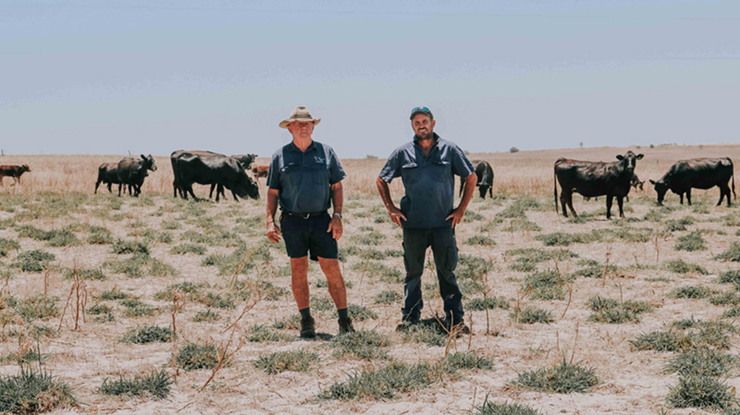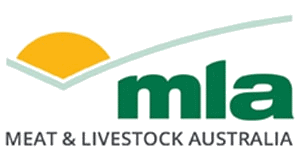Nutrition drives embryo success
15 April 2025
 Craig Forsyth (left) with his son Nathan in front of their Angus breeders, which they use as part of their embryo recipient program Image: Shannah Kanny.
Craig Forsyth (left) with his son Nathan in front of their Angus breeders, which they use as part of their embryo recipient program Image: Shannah Kanny.
A focus on nutrition underpins the success of WA beef producer Craig Forsyth’s extensive embryo recipient program in his Angus breeding herd at ‘Avoca Farms’, Irwin.
Craig works alongside his wife Donelle and their son Nathan – the enterprise has been in his family for 48 years.
“We’ve always run cattle, but over the years we’ve extended our business to take on animals from other producers thanks to our focus on nutrition and increasing our feedbase,” Craig said.
“We initially started by taking on cattle for backgrounding on our pastures before they were transported to another feedlot or an abattoir for live export, with the owner/producer paying us for the weight gain that occurs.”
Four years ago, a new business venture came about, when their vet – who was producing Wagyu-fertilised embryos – approached the Forsyths to see if their Angus cows could be the embryo recipients.
“We’ve been doing fixed AI for 21 years at this point, so we felt pretty confident about the prospect of trialling this venture,” Craig said.
Addressing constraints
While Craig’s focus on nutrition has made his services sought after, he said ensuring a high-quality nutrition and feedbase supply has not come without its challenges.
“We’ve got a lot of inequalities within our soils with areas of low fertility appearing across the property,” he said.
“Our summers are very hot and dry and while we do experience the rare summer thunderstorm every now and then, the majority of our 450mm rainfall is contained within our May–October growing season.”
They combat these constraints with fertiliser, mineral supplementation and planting premium-growth subtropical pastures.
“Our biggest challenge has been maintaining pasture and cattle condition during autumn,” Craig said.
“Originally, soil testing and fertiliser was our go-to solution, but for the past 30 years we’ve been planting Gatton panic and Rhodes grasses, as they offer a more extended growing system than typical ryegrass pastures in WA.
“Good symbiosis also occurs between these subtropical pastures and our perennial pastures which means that if we do get a summer thunderstorm, then we have pastures that will really come forward and provide a good range of nutrition for our cattle.”
Key role of good nutrition
In addition to providing good nutrition through pastures, Craig has found benefits from going the extra mile and providing his cattle with year-round supplementation, delivered through the herd’s water.
“We use different minerals for our different livestock classes, with cobalt sulphate for our backgrounding cattle, electrolytes for our cattle that are about to be transported, and a mixed mineral rich in magnesium for our calving cows.
“As a result of this, our cattle are able to maintain good levels of hydration and nutrition during both short-term impacts, like transportation, and long-term impacts, like dry seasonal conditions.”
When there’s a particularly hot and dry summer, Craig also puts out a cattle lick with phosphorus to ensure the herd’s nutritional needs are met during periods when pastures are impacted.
Creating a routine
According to Craig, a key element to ensuring cattle receive the most nutritional benefits possible from his feedbase is having a well-planned reproduction system, which lines up with the pasture growth cycle.
“We start in late July with our embryo recipient program, giving a Gonadiol® injection and inserting an intravaginal progesterone delivery device known as Cue-Mate® into our selected cows on what we call day zero,” Craig said.
“Eight days later, we remove the Cue-Mate®, apply heat detection patches, and administer a Novormon® injection before delivering another Gonadiol® injection on day nine.
“The fertilised Wagyu embryos are inserted on day 17 with the use of Lignocaine to keep the process pain and stress free.
“We then bring out Wagyu bulls in with our heifers and our Angus bulls in with our cows to impregnate those who aren’t carrying the Wagyu embryos – supplying us with replacement heifers and feedlot steers.”
This puts their herd on a late autumn/early winter calving system, with heifers calving in the last few weeks of May and cows calving in June.
“We like to keep our calving timeline reasonably tight as the better pasture quality and availability during our winter period means our lactating mothers are having their nutritional needs well met – benefiting both the mother and her calf,” Craig said.
“We wean in December–January, and we yard wean for 30 days before the Wagyu calves from the embryo recipient program are put on a backgrounding rotation – lining up nicely with that boost in pasture condition we get following summer rainfall.”
Return on investment
While Craig said it’s important to note that taking part in an embryo recipient program requires a lot more yard work with less flexibility of timing, the return on investment is worth it for them.
“Having an embryo recipient program does call for a bit more of our time than just putting our bulls in with our cows,” Craig said.
“Things have to be done on time, especially the insertion and removal of the Cue-Mate® devices which are both done at around 6:30am on their respective days.
“We also need to keep good records of injections given, embryos inserted and pregnancy test results.
“However, as part of our agreement with our vet as the embryo owner, he pays to have genomic testing done on our cows,” Craig said.
“This is great in helping us with recording data that highlights the status of cows – allowing us to determine which ones are better suited to the embryo recipient program, which ones have the preferred genetic traits we want passed on to our replacement heifers, and which ones should be culled.”
He said genomic testing is also beneficial in ensuring calf survivability rates.
“We get paid for every Wagyu calf from the recipient program that’s weaned,” he said.
“This year, approximately 190 of the 360 embryos we implanted became viable pregnancies and our calf survival rate was 100%.
“Overall, I’m getting a great return on investment from the program using my Angus heifers and cows to carry Wagyu embryos – it has really allowed for a nice boost in profitability. We’ve been able to increase the number of embryos we implant every year.”
Opportunities
When asked for his key takeaways from adopting an embryo recipient program into his reproductive system, Craig said its results highlighted the importance of having a good nutritional focus and taking opportunities to expand your business when viable.
“No matter what your reproduction system entails, ensuring your heifers and cows are supplied with good nutrition will allow for improved productivity,” he said.
“For us, a focus on nutrition supply has not only benefited natural pregnancies and artificial pregnancies, it’s also opened the door to opportunities to increase profitability of our business.”


